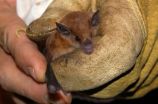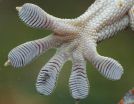(Press-News.org) Protecting wildlife while feeding a world population predicted to reach 9 billion by 2050 will require a holistic approach to conservation that considers human-altered landscapes such as farmland, according to Stanford researchers.
Wildlife and the natural habitat that supports it might be an increasingly scarce commodity in a world where at least three-quarters of the land surface is directly affected by humans and the rest is vulnerable to human-caused impacts such as climate change. But what if altered agricultural landscapes could play vital roles in nurturing wildlife populations while also feeding an ever-growing human population?
A new study, published April 16 in the journal Nature and co-authored by three Stanford scientists, finds that a long-accepted theory used to estimate extinction rates, predict ecological risk and make conservation policy recommendations is overly pessimistic. The researchers point to an alternative framework that promises a more effective way of accounting for human-altered landscapes and assessing ecological risks.
Current projections forecast that about half of Earth's plants and animals will go extinct over the next century because of human activities, mostly due to our agricultural methods. "The extinction under way threatens to weaken and even destroy key parts of Earth's life-support systems, upon which economic prosperity and all other aspects of human well-being depend," said co-author Gretchen Daily, the Bing Professor in Environmental Science at Stanford and senior fellow at the Stanford Woods Institute for the Environment.
But that grim future isn't a foregone conclusion.
"Until the next asteroid slams into Earth, the future of all known life hinges on people, more than on any other force," Daily said.
Nature is not an island
Conservationists have long assumed that once natural landscapes are fractured by human development or agriculture, migration corridors for wildlife are broken, blocking access to food, shelter and breeding grounds. A scholarly theory was developed to estimate the number of species in such fractured landscapes, where patches of forest surrounded by farms resemble islands of natural habitat.
The "equilibrium theory of island biogeography" is a pillar of biological research – its elegant equation to estimate the number of species in a habitat has almost reached the status of a scientific law, according to Chase Mendenhall, a Stanford doctoral student in biology and the study's lead author. The theory drives the default strategy of conserving biodiversity by designating nature reserves. This strategy sees reserves as "islands in an inhospitable sea of human-modified habitats" and doesn't adequately account for biodiversity patterns in many human-dominated landscapes, according to the Stanford study.
"This paper shows that farmland and forest remnants can be more valuable for biodiversity than previously assumed," said Daniel Karp, who earned his PhD in biology at Stanford in 2013 and is currently a NatureNet postdoctoral fellow at the University of California, Berkeley.
"If we're valuing coffee fields and other human-made habitats at zero, we're doing a disservice to ourselves and wildlife," Mendenhall said.
To test the island theory against a more holistic theory of agricultural or countryside biogeography, the researchers turned to bats acutely sensitive to deforestation. The study focused on bat populations within a mosaic of forest fragments and farmland in Costa Rica and on islands in a large lake in Panama. The researchers also did a meta-analysis of 29 studies of more than 700 bat species to bolster and generalize their findings globally.
Island biogeographic theory accurately predicted bats' responses to forest loss on the Panamanian islands system, but didn't come close to accurately forecasting similar responses in the Costa Rican countryside landscape. For example, the island theory predicted that the Costa Rican coffee plantations would have inadequate habitat to sustain a single species of bat. In reality, plantations in the countryside typically supported 18 bat species, compared to the 23 to 28 supported by tropical forest fragments and nature reserves.
"Conservation opportunities for tropical wildlife are tightly linked to adequate management of these human-modified habitats," said co-author Christoph Meyer, a researcher at the University of Lisbon's Center for Environmental Biology.
Overall, as forest cover disappeared, the rate of species loss was "substantially and significantly higher" in the island ecosystem, and species abundances were "increasingly uneven" compared to the countryside ecosystem, the study found.
The reason for the discrepancies, according to the study's authors, is that island biogeographic theory was originally based on actual islands surrounded by water, and does not account for factors such as a countryside landscape's ability to support more species and slow extinction rates compared to true island ecosystems. Especially in the tropics, island biogeographic theory's application is "distorting our understanding and conservation strategies in agriculture, the enterprise on which the future of biodiversity most critically hinges," the study's authors wrote.
"Not only do more species persist across the 'sea of farmland' than expected by island biogeographic theory, novel yet native species actually thrive there," said co-author Elizabeth Hadly, the Paul S. and Billie Achilles Professor in Environmental Biology at Stanford and senior fellow at the Stanford Woods Institute for the Environment. "This indicates that human-altered landscapes can foster more biological diversity than we anticipated."
A new approach
The fate of much of the world's wildlife is playing out in human-altered landscapes that are increasingly threatened by chemical inputs such as herbicides and pesticides. Biodiversity is not the only loser. People are losing many of nature's benefits such as water purification provided by forests and wetlands and pest control provided by birds and bats.
The study's findings point to the need for new approaches that integrate conservation and food production, to make agricultural lands more hospitable to wildlife by reducing chemical inputs, preserving fragments of forest and other natural habitats and rewarding farmers and ranchers for the benefits that result.
"A theory of countryside biogeography is pivotal to conservation strategy in the agricultural ecosystems that comprise roughly half of the global land surface and are likely to increase even further in the future," the researchers wrote.
INFORMATION:
Stanford researchers rethink 'natural' habitat for wildlife
2014-04-18
ELSE PRESS RELEASES FROM THIS DATE:
Finding turns neuroanatomy on its head
2014-04-18
Harvard neuroscientists have made a discovery that turns 160 years of neuroanatomy on its head.
Myelin, the electrical insulating material long known to be essential for the fast transmission of impulses along the axons of nerve cells, is not as ubiquitous as thought, according to a new work lead by Professor Paola Arlotta of the Harvard Stem Cell Institute (HSCI) and the University's Department of Stem Cell and Regenerative Biology, in collaboration with Professor Jeff Lichtman, of Harvard's Department of Molecular and Cellular Biology.
"Myelin is a relatively recent ...
Researchers question published no-till soil organic carbon sequestration rates
2014-04-18
URBANA, Ill. For the past 20 years, researchers have published soil organic carbon sequestration rates. Many of the research findings have suggested that soil organic carbon can be sequestered by simply switching from moldboard or conventional tillage systems to no-till systems. However, there is a growing body of research with evidence that no-till systems in corn and soybean rotations without cover crops, small grains, and forages may not be increasing soil organic carbon stocks at the published rates.
"Some studies have shown that both moldboard and no-till systems ...
Sun emits a mid-level solar flare
2014-04-18
The sun emitted a mid-level solar flare, peaking at 9:03 a.m. EDT on April 18, 2014, and NASA's Solar Dynamics Observatory captured images of the event. Solar flares are powerful bursts of radiation. Harmful radiation from a flare cannot pass through Earth's atmosphere to physically affect humans on the ground, however -- when intense enough -- they can disturb the atmosphere in the layer where GPS and communications signals travel.
To see how this event may impact Earth, please visit NOAA's Space Weather Prediction Center at http://spaceweather.gov, the U.S. government's ...
Researchers find 3-million-year-old landscape beneath Greenland ice sheet
2014-04-18
Glaciers and ice sheets are commonly thought to work like a belt sander. As they move over the land they scrape off everything — vegetation, soil and even the top layer of bedrock. So a team of university scientists and a NASA colleague were greatly surprised to discover an ancient tundra landscape preserved under the Greenland Ice Sheet, below two miles of ice.
"We found organic soil that has been frozen to the bottom of the ice sheet for 2.7 million years," said University of Vermont geologist and lead author Paul Bierman. The finding provides strong evidence that the ...
Religious music brings benefit to seniors' mental health
2014-04-18
A new article published online in The Gerontologist reports that among older Christians, listening to religious music is associated with a decrease in anxiety about death and increases in life satisfaction, self-esteem, and sense of control over their lives. In particular, listening to gospel music is associated with a decrease in anxiety about death and an increase in sense of control.
These associations are similar for blacks and whites, women and men, and individuals of both low- and high-socioeconomic status.
The article, titled "Listening to Religious Music and ...
Ancient DNA offers clues to how barnyard chickens came to be
2014-04-18
Durham, NC — Ancient DNA adds a twist to the story of how barnyard chickens came to be, finds a study to be published April 21 in the journal Proceedings of the National Academy of Sciences.
Analyzing DNA from the bones of chickens that lived 200-2300 years ago in Europe, researchers report that just a few hundred years ago domestic chickens may have looked far different from the chickens we know today.
The results suggest that some of the traits we associate with modern domestic chickens -- such as their yellowish skin -- only became widespread in the last 500 years, ...
Plants with dormant seeds give rise to more species
2014-04-18
Durham, NC — Seeds that sprout as soon as they're planted may be good news for a garden. But wild plants need to be more careful. In the wild, a plant whose seeds sprouted at the first
warm spell or rainy day would risk disaster. More than just an insurance policy against late frosts or unexpected dry spells, it turns out that seed dormancy has long-term advantages too: Plants whose seeds put off sprouting until conditions are more certain give rise to more species, finds in a team of researchers working at the National Evolutionary Synthesis Center in North Carolina.
When ...
Gecko-like adhesives now useful for real world surfaces
2014-04-18
AMHERST, Mass. – The ability to stick objects to a wide range of surfaces such as drywall, wood, metal and glass with a single adhesive has been the elusive goal of many research teams across the world, but now a team of University of Massachusetts Amherst inventors describe a new, more versatile version of their invention, Geckskin, that can adhere strongly to a wider range of surfaces, yet releases easily, like a gecko's feet.
"Imagine sticking your tablet on a wall to watch your favorite movie and then moving it to a new location when you want, without the need for ...
'Exotic' material is like a switch when super thin
2014-04-18
ITHACA, N.Y. – Researchers from Cornell University and Brookhaven National Laboratory have shown how to switch a particular transition metal oxide, a lanthanum nickelate (LaNiO3), from a metal to an insulator by making the material less than a nanometer thick.
Ever-shrinking electronic devices could get down to atomic dimensions with the help of transition metal oxides, a class of materials that seems to have it all: superconductivity, magnetoresistance and other exotic properties. These possibilities have scientists excited to understand everything about these materials, ...
New study suggests a better way to deal with bad memories
2014-04-18
What's one of your worst memories? How did it make you feel? According to psychologists, remembering the emotions felt during a negative personal experience, such as how sad you were or how embarrassed you felt, can lead to emotional distress, especially when you can't stop thinking about it.
When these negative memories creep up, thinking about the context of the memories, rather than how you felt, is a relatively easy and effective way to alleviate the negative effects of these memories, a new study suggests.
Researchers at the Beckman Institute at the University ...







